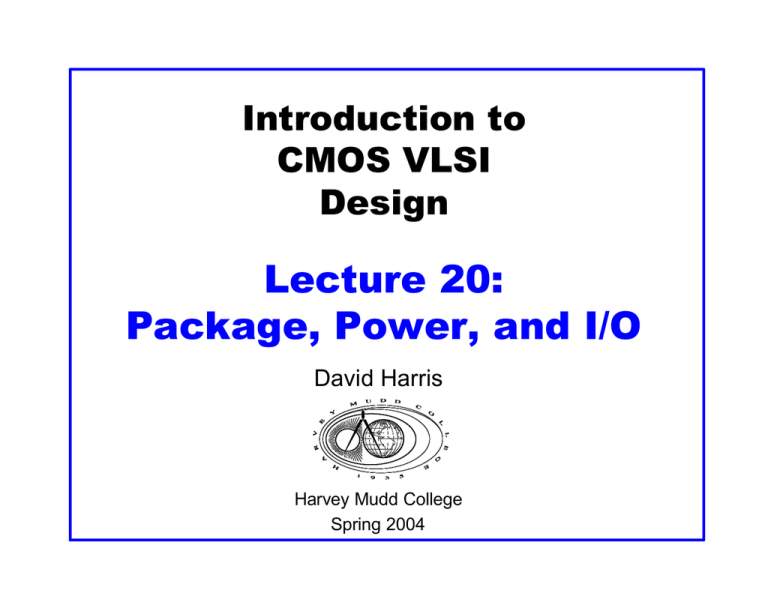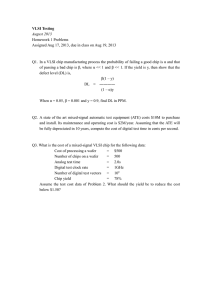Lecture 20: Package, Power, and I/O
advertisement

Introduction to CMOS VLSI Design Lecture 20: Package, Power, and I/O David Harris Harvey Mudd College Spring 2004 Outline q q q q Packaging Power Distribution I/O Synchronization 20: Package, Power, and I/O CMOS VLSI Design Slide 2 Packages q Package functions – Electrical connection of signals and power from chip to board – Little delay or distortion – Mechanical connection of chip to board – Removes heat produced on chip – Protects chip from mechanical damage – Compatible with thermal expansion – Inexpensive to manufacture and test 20: Package, Power, and I/O CMOS VLSI Design Slide 3 Package Types q Through-hole vs. surface mount 20: Package, Power, and I/O CMOS VLSI Design Slide 4 Multichip Modules q Pentium Pro MCM – Fast connection of CPU to cache – Expensive, requires known good dice 20: Package, Power, and I/O CMOS VLSI Design Slide 5 Chip-to-Package Bonding q Traditionally, chip is surrounded by pad frame – Metal pads on 100 – 200 µm pitch – Gold bond wires attach pads to package – Lead frame distributes signals in package – Metal heat spreader helps with cooling 20: Package, Power, and I/O CMOS VLSI Design Slide 6 Advanced Packages q Bond wires contribute parasitic inductance q Fancy packages have many signal, power layers – Like tiny printed circuit boards q Flip-chip places connections across surface of die rather than around periphery – Top level metal pads covered with solder balls – Chip flips upside down – Carefully aligned to package (done blind!) – Heated to melt balls – Also called C4 (Controlled Collapse Chip Connection) 20: Package, Power, and I/O CMOS VLSI Design Slide 7 Package Parasitics q Use many VDD, GND in parallel – Inductance, IDD Package Signal Pads Signal Pins 20: Package, Power, and I/O Chip VDD Bond Wire Lead Frame Board V DD Package Capacitor Chip Chip GND CMOS VLSI Design Board GND Slide 8 Heat Dissipation q 60 W light bulb has surface area of 120 cm2 q Itanium 2 die dissipates 130 W over 4 cm2 – Chips have enormous power densities – Cooling is a serious challenge q Package spreads heat to larger surface area – Heat sinks may increase surface area further – Fans increase airflow rate over surface area – Liquid cooling used in extreme cases ($$$) 20: Package, Power, and I/O CMOS VLSI Design Slide 9 Thermal Resistance q ∆T = θjaP – ∆T: temperature rise on chip – θja: thermal resistance of chip junction to ambient – P: power dissipation on chip q Thermal resistances combine like resistors – Series and parallel q θja = θjp + θpa – Series combination 20: Package, Power, and I/O CMOS VLSI Design Slide 10 Example q Your chip has a heat sink with a thermal resistance to the package of 4.0° C/W. q The resistance from chip to package is 1° C/W. q The system box ambient temperature may reach 55° C. q The chip temperature must not exceed 100° C. q What is the maximum chip power dissipation? 20: Package, Power, and I/O CMOS VLSI Design Slide 11 Example q Your chip has a heat sink with a thermal resistance to the package of 4.0° C/W. q The resistance from chip to package is 1° C/W. q The system box ambient temperature may reach 55° C. q The chip temperature must not exceed 100° C. q What is the maximum chip power dissipation? q (100-55 C) / (4 + 1 C/W) = 9 W 20: Package, Power, and I/O CMOS VLSI Design Slide 12 Power Distribution q Power Distribution Network functions – Carry current from pads to transistors on chip – Maintain stable voltage with low noise – Provide average and peak power demands – Provide current return paths for signals – Avoid electromigration & self-heating wearout – Consume little chip area and wire – Easy to lay out 20: Package, Power, and I/O CMOS VLSI Design Slide 13 Power Requirements q VDD = VDDnominal – Vdroop q Want Vdroop < +/- 10% of VDD q Sources of Vdroop – IR drops – L di/dt noise q IDD changes on many time scales Power Max clock gating Average Min Time 20: Package, Power, and I/O CMOS VLSI Design Slide 14 Power System Model q Power comes from regulator on system board – Board and package add parasitic R and L – Bypass capacitors help stabilize supply voltage – But capacitors also have parasitic R and L q Simulate system for time and frequency responses Voltage Regulator VDD Bulk Capacitor Printed Circuit Board Planes Ceramic Capacitor Board 20: Package, Power, and I/O Package and Pins Solder Bumps Package Capacitor On-Chip Capacitor Chip On-Chip Current Demand Package CMOS VLSI Design Slide 15 Bypass Capacitors q Need low supply impedance at all frequencies q Ideal capacitors have impedance decreasing with ω q Real capacitors have parasitic R and L – Leads to resonant frequency of capacitor 10 2 1 10 1 µF 0.25 nH impedance 0.03 Ω 10 10 10 0 -1 -2 10 4 10 5 10 6 10 7 10 8 10 9 10 10 frequency (Hz) 20: Package, Power, and I/O CMOS VLSI Design Slide 16 Frequency Response q Use multiple capacitors in parallel – Large capacitor near regulator has low impedance at low frequencies – But also has a low self-resonant frequency – Small capacitors near chip and on chip have low impedance at high frequencies q Choose caps to get low impedance at all frequencies impedance frequency (Hz) 20: Package, Power, and I/O CMOS VLSI Design Slide 17 Input / Output q Input/Output System functions – Communicate between chip and external world – Drive large capacitance off chip – Operate at compatible voltage levels – Provide adequate bandwidth – Limit slew rates to control di/dt noise – Protect chip against electrostatic discharge – Use small number of pins (low cost) 20: Package, Power, and I/O CMOS VLSI Design Slide 18 I/O Pad Design q Pad types – VDD / GND – Output – Input – Bidirectional – Analog 20: Package, Power, and I/O CMOS VLSI Design Slide 19 Output Pads q Drive large off-chip loads (2 – 50 pF) – With suitable rise/fall times – Requires chain of successively larger buffers q Guard rings to protect against latchup – Noise below GND injects charge into substrate – Large nMOS output transistor – p+ inner guard ring – n+ outer guard ring • In n-well 20: Package, Power, and I/O CMOS VLSI Design Slide 20 Input Pads q Level conversion – Higher or lower off-chip V – May need thick oxide gates q Noise filtering A – Schmitt trigger – Hysteresis changes VIH, VIL VDDH A VDDL Y VDDL A Y weak Y Y weak A q Protection against electrostatic discharge 20: Package, Power, and I/O CMOS VLSI Design Slide 21 ESD Protection q Static electricity builds up on your body – Shock delivered to a chip can fry thin gates – Must dissipate this energy in protection circuits before it reaches the gates Diode clamps q ESD protection circuits R PAD – Current limiting resistor Thin Current gate limiting oxides – Diode clamps resistor q ESD testing 1500 Ω – Human body model 100 pF – Views human as charged capacitor 20: Package, Power, and I/O CMOS VLSI Design Device Under Test Slide 22 Bidirectional Pads q Combine input and output pad q Need tristate driver on output – Use enable signal to set direction – Optimized tristate avoids huge series transistors PAD En Din Dout NAND Dout En Y Dout NOR 20: Package, Power, and I/O CMOS VLSI Design Slide 23 Analog Pads q Pass analog voltages directly in or out of chip – No buffering – Protection circuits must not distort voltages 20: Package, Power, and I/O CMOS VLSI Design Slide 24 MOSIS I/O Pad q 1.6 µm two-metal process – Protection resistors – Protection diodes – Guard rings – Field oxide clamps PAD 600/3 264 Ω 185 Ω Out 240 48 90 160 20 40 En In Out In_unbuffered 20: Package, Power, and I/O In_b CMOS VLSI Design Slide 25



